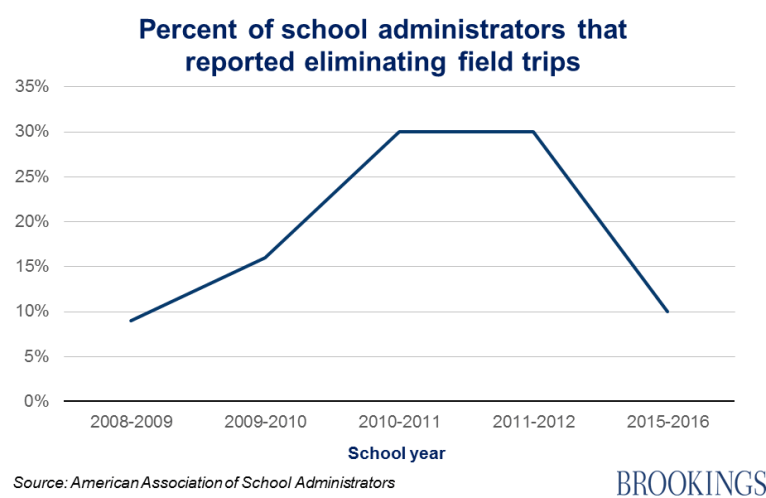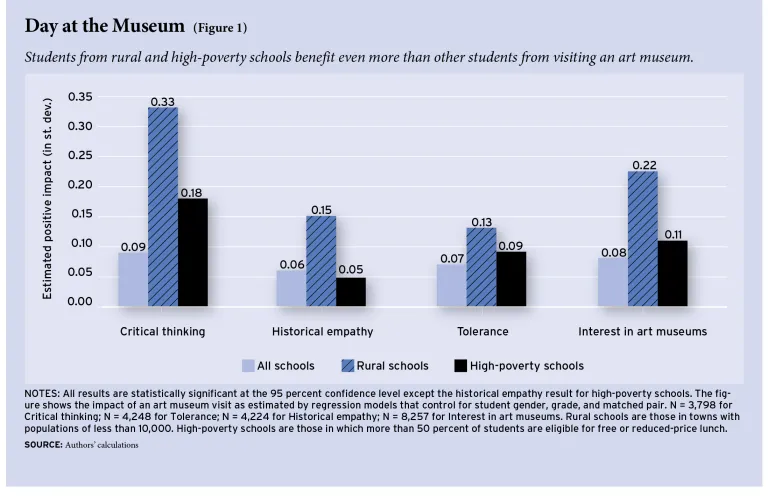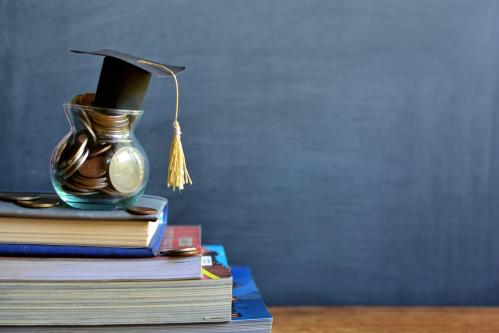As every good teacher knows, education is not just about academics. It is about broadening horizons and discovering passions. (The root of education is the Latin e ducere, meaning “to draw out.”) From this perspective, extra-curricular activities count for a great deal. But as Robert Putnam highlights in his book Our Kids, there are growing class gaps in the availability of music, sports, and other non-classroom activities.
Fewer field trips?
Schools under pressure may also cut back on field trips outside the school walls to parks, zoos, theaters, or museums. In the 2008-09 school year, 9 percent of school administrators reported eliminating field trips, according to the annual surveys by the American Association of School Administrators (AASA). That figure rose through the recession:

Just 12 percent of the administrators surveyed about 2015-16 said they had brought back their field trips to pre-recession levels. Museums around the country report hosting fewer students, from Los Angeles and Sarasota, to Minneapolis, and Columbia, Missouri. None of this is definitive proof of a decline in field trips, since we are relying on a single survey question. But it suggests a downward trend in recent years.
Museums help with science tests
If some children are missing out on field trips, does it matter? They may be nice treats, but do they have any real impact, especially when they take time away from traditional learning? There is some evidence that they do.
Middle school children with the chance to go on a field trip score higher on science tests, according to a 2015 study by Emilyn Ruble Whitesell.
She studied New York City middle schools with teachers in Urban Advantage, a program that gives science teachers additional training and resources—as well as vouchers for visiting museums. In some schools, the Urban Advantage teachers used the field trip vouchers more than others. Whitesell exploits this difference in her study, and finds that attending a school with at least 0.25 trips per student increased 8th grade scores by 0.026 standard deviations (SD). The odds of a student passing the exam improved by 1.2 percentage points. There were bigger effects for poor students, who saw a 0.043 SD improvement in test scores, and 1.9 percentage point increase in exam pass rates.
Art broadens young minds
Students visiting an art museum show statistically significant increases in critical thinking ability and more open-minded attitudes, according to a randomized evaluation of student visits to the Crystal Bridges Museum in northwest Arkansas. One example: those who visited the museum more often agreed with statements like: “I appreciate hearing views different from my own” and “I think people can have different opinions about the same thing.” The effects are modest. But the intervention (a single day at the museum) is, too. Again, there were larger effects for poor students:

All this needs to be put in perspective. In comparison with the challenge of closing academic gaps and quality teaching, field trips are small beer. But schools create citizens as well as undergraduates and employees. It matters, then, if we have allowed field trips to become a casualty of the great recession.




Commentary
Fewer field trips mean some students miss more than a day at the museum
June 8, 2016